Air con Citroen BERLINGO MULTISPACE 2015 2.G Owner's Guide
[x] Cancel search | Manufacturer: CITROEN, Model Year: 2015, Model line: BERLINGO MULTISPACE, Model: Citroen BERLINGO MULTISPACE 2015 2.GPages: 298, PDF Size: 12.69 MB
Page 74 of 298
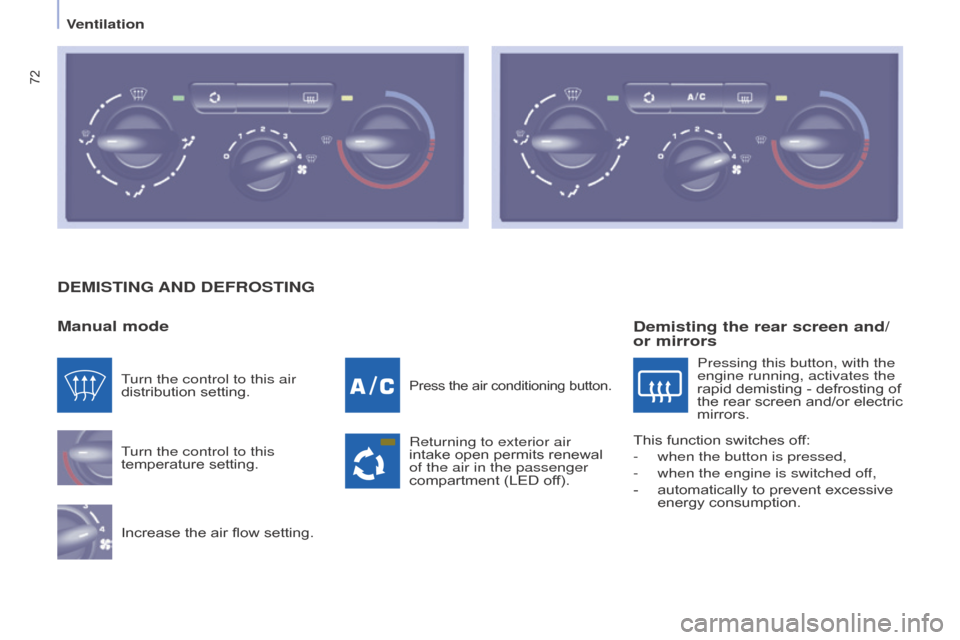
72
Berlingo-2-VP_en_Chap04_Ergonomie_ed01-2015Berlingo-2-VP_en_Chap04_Ergonomie_ed01-2015
DEMISTING AND DEFROSTING
Manual mode
Turn the control to this
temperature setting.
Increase
the air flow setting.
Press the air conditioning button.
Returning to exterior air
intake open permits renewal
of the air in the passenger
compartment
(LED off).
Turn the control to this air
distribution
setting.
Demisting the rear screen and/
or mirrors
Pressing this button, with the
engine running, activates the
rapid
demisting - defrosting of
the
rear screen and/or electric
mirrors.
This
function switches off:
-
when the button is pressed,
-
when the engine is switched of
f,
-
automatically
to prevent excessive
energy
consumption.
Ventilation
Page 75 of 298
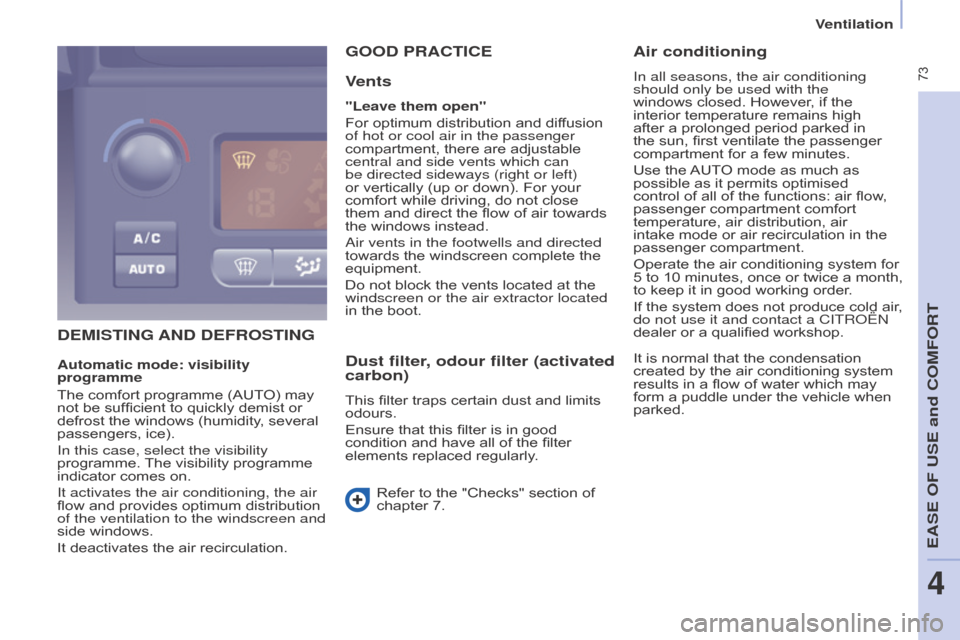
73
Berlingo-2-VP_en_Chap04_Ergonomie_ed01-2015Berlingo-2-VP_en_Chap04_Ergonomie_ed01-2015
DEMISTING AND DEFROSTING
G
OOD PRACTICE
V
ents
"Leave them open"
For
optimum distribution and diffusion
of hot or cool air in the passenger
compartment,
there are adjustable
central and side vents which can
be directed sideways (right or left)
or
vertically (up or down). For your
comfort
while driving, do not close
them
and direct the flow of air towards
the
windows instead.
a
ir vents in the footwells and directed
towards
the windscreen complete the
equipment.
Do
not block the vents located at the
windscreen or the air extractor located
in
the boot.
Dust filter, odour filter (activated
carbon)
This filter traps certain dust and limits odours.
Ensure that this filter is in good
condition
and have all of the filter
elements
replaced regularly.
Refer
to the "Checks" section of
chapter
7.
Air conditioning
In all seasons, the air conditioning
should only be used with the
windows closed. However, if the
interior
temperature remains high
after
a prolonged period parked in
the
sun, first ventilate the passenger
compartment
for a few minutes.
Use
the
AUT
O mode as much as
possible
as it permits optimised
control
of all of the functions: air flow,
passenger
compartment comfort
temperature,
air distribution, air
intake
mode or air recirculation in the
passenger
compartment.
Operate
the air conditioning system for
5
to
10
minutes,
once
or
twice
a
month,
to
keep it in good working order.
If
the system does not produce cold air,
do not use it and contact a CITR
o Ë n
dealer
or a qualified workshop.
Automatic mode: visibility
programme
The
comfort
programme
(AUTO)
may
not
be
sufficient
to
quickly
demist
or
defrost
the
windows
(humidity,
several
passengers,
ice).
In this case, select the visibility
programme.
The
visibility
programme
indicator
comes
on.
It activates the air conditioning, the air
flow
and
provides
optimum
distribution
of the ventilation to the windscreen and
side
windows.
It
deactivates
the
air
recirculation. It
is normal that the condensation
created
by the air conditioning system
results
in a flow of water which may
form
a puddle under the vehicle when
parked.
EASE OF USE and COMFORT
4
Ventilation
Page 98 of 298

96
Berlingo-2-VP_en_Chap04_Ergonomie_ed01-2015Berlingo-2-VP_en_Chap04_Ergonomie_ed01-2015
From insideFrom outside
Rear box
This roof box can be accessed from the
rear seats and the boot.
From
the rear seats, slide the flaps to
open.
Vents
a 3-position control allows you to
adjust the air flow through the vents.
The
vents are also fitted with a scented
air
freshener.
From
the
boot,
place
your
thumb
on
the recess then pull the handle to
open.
Open
carefully
to
prevent
objects
stored
in
this
interior
roof
box
from
fallin
g
out.
The
maximum
authorised
load
is
10
kg.
Practical information
Page 99 of 298

97
Berlingo-2-VP_en_Chap04_Ergonomie_ed01-2015Berlingo-2-VP_en_Chap04_Ergonomie_ed01-2015
SCENTED AIR FRESHENER
The scented air freshener diffuses
a fragrance in the passenger
compartment from the roof console
vents.
Adjusting the flow
Turn the chromed button to adjust the diffusion:
-
to the left to decrease,
-
to
the right to increase.
To
stop the diffusion, turn the chromed
button
fully to the left.
Removing the scented air
freshener
- Press the button down while turning
it a quarter of a turn to the left to
the stop.
-
Remove
the scented air freshener
from
the roof console.
-
Replace
the cartridge.
EASE OF USE and COMFORT
4
Practical information
Page 100 of 298

98
Berlingo-2-VP_en_Chap04_Ergonomie_ed01-2015Berlingo-2-VP_en_Chap04_Ergonomie_ed01-2015
Replacing a cartridge
The scented air freshener refill consists of a cartridge B and its sealing case C.
-
Remove
the protective film D.
-
Place the head of the cartridge
B
on the button A of the scented air
freshener.
-
T
urn it a quarter of a turn to lock it
on
the button and remove the case.
-
Insert the scented air freshener in
its
location.
You can change the cartridges at any
time
and store cartridges which have
already been started in their original
case.
The scented air freshener button
A is
independent
of the cartridge.
The cartridges are supplied without the
button A.
Inserting the scented air
freshener
After fitting or changing the cartridge:
-
Put
the scented air freshener back
in
place in its location.
-
T
urn it a quarter of a turn to the
right.
Good practice
as a safety precaution, only use the
cartridges provided for this purpose.
Do
not dismantle the cartridges.
k
eep the cartridge sealing cases
which
are used as packaging when the
cartridges
are not in use.
Never
try to refill the cartridges with
fragrances other than those available
from
CITROËN dealers.
k
eep out of reach of children and
animals.
A
void contact with the skin
and
eyes. If swallowed, consult a
doctor
and show him the packaging or
product
label.
The scented air freshener button A can
only
be
fixed
on
the
multifunction
roof
console
with
a
cartridge.
Therefore, always retain button A and
a
cartridge.
The
cartridges
are
available
from
CITROËN
dealers.
Practical information
Page 118 of 298
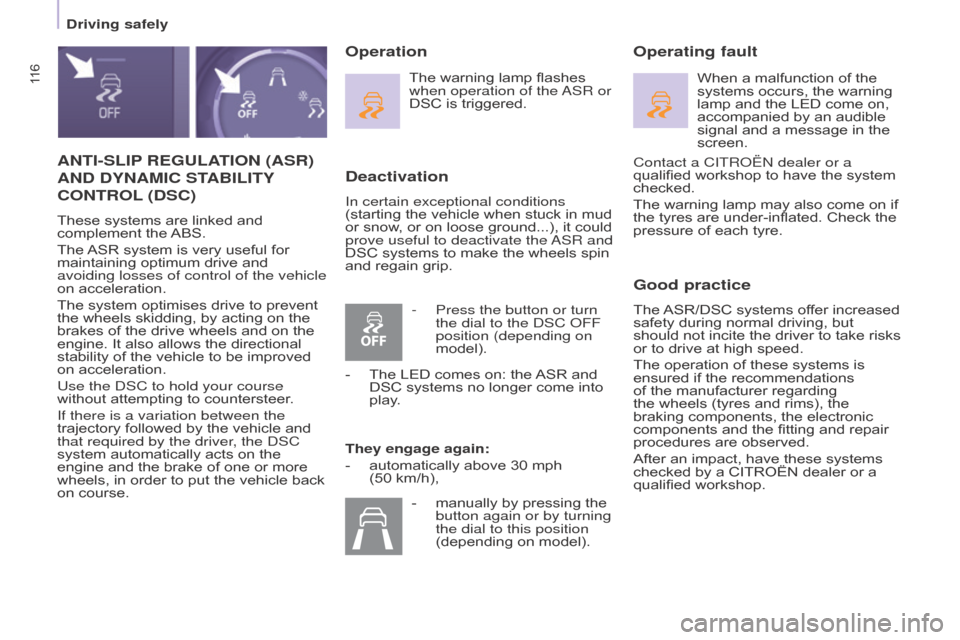
11 6
Berlingo-2-VP_en_Chap05_Securite_ed01-2015
ANTI-SLIP REGULATION (ASR)
AND
DYNAMIC STABILITY
CONTROL (DSC)
These systems are linked and complement the ABS.
The
ASR
system is very useful for
maintaining
optimum drive and
avoiding losses of control of the vehicle
on
acceleration.
The
system optimises drive to prevent
the
wheels skidding, by acting on the
brakes
of the drive wheels and on the
engine.
It also allows the directional
stability
of the vehicle to be improved
on
acceleration.
Use the
d SC to hold your course
without
attempting to countersteer.
If there is a variation between the
trajectory
followed by the vehicle and
that required by the driver
, the d SC
system
automatically acts on the
engine
and the brake of one or more
wheels,
in order to put the vehicle back
on
course.
Deactivation
In certain exceptional conditions
(starting the vehicle when stuck in mud
or
snow, or on loose ground...), it could
prove useful to deactivate the a
SR and
DSC
systems to make the wheels spin
and
regain grip.
Operating fault
Good practice
The ASR/DSC systems offer increased safety
during normal driving, but
should
not incite the driver to take risks
or
to drive at high speed.
The
operation of these systems is
ensured
if the recommendations
of
the manufacturer regarding
the
wheels (tyres and rims), the
braking
components, the electronic
components
and the fitting and repair
procedures
are observed.
After
an impact, have these systems
checked
by a CITROËN dealer or a
qualified
workshop.
Operation
The warning lamp flashes when operation of the a SR or
DSC
is triggered.
They engage again:
-
automatically
above 30 mph
(50
km/h), When
a malfunction of the systems
occurs, the warning
lamp
and the LED come on,
accompanied
by an audible
signal
and a message in the
screen.
-
Press the button or turn
the dial to the
d SC o FF
position (depending on
model).
-
The
LED comes on: the
ASR
and
DSC
systems no longer come into
play
. -
manually
by pressing the
button again or by turning
the dial to this position
(depending
on model).Contact a CITR
o Ë n dealer or a
qualified
workshop to have the system
checked.
The
warning lamp may also come on if
the
tyres are under-inflated. Check the
pressure
of each tyre.
driving safely
Page 125 of 298
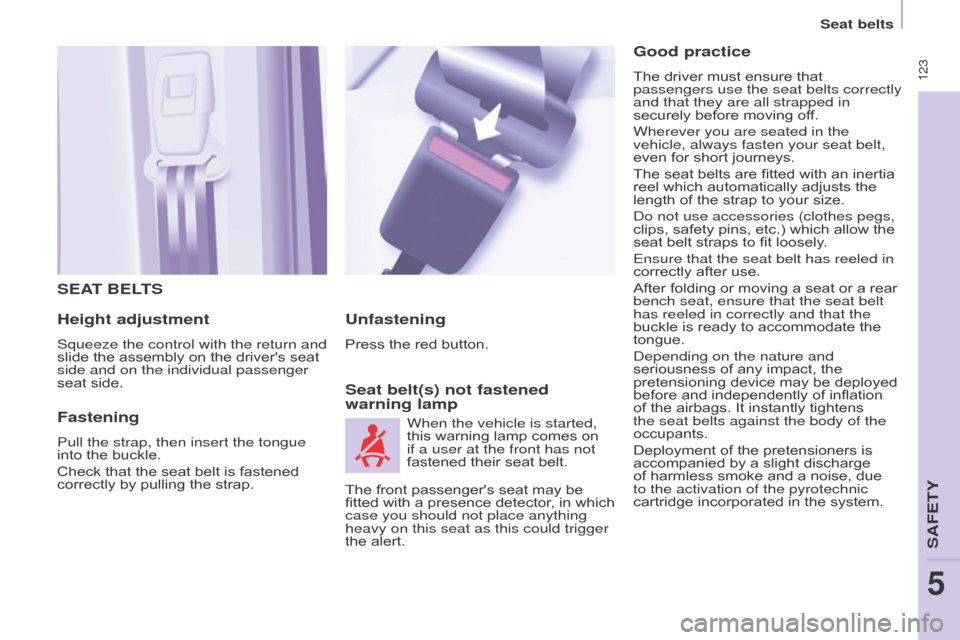
Berlingo-2-VP_en_Chap05_Securite_ed01-2015
123
SEAT BELTS
Height adjustment
Squeeze the control with the return and
slide the assembly on the driver's seat
side and on the individual passenger
seat
side.
Fastening
Pull the strap, then insert the tongue
into the buckle.
Check
that the seat belt is fastened
correctly
by pulling the strap.
Seat belt(s) not fastened
warning lamp Unfastening
Press the red button.
When the vehicle is started,
this
warning lamp comes on
if a user at the front has not
fastened
their seat belt.
Good practice
The driver must ensure that passengers use the seat belts correctly
and that they are all strapped in
securely before moving off.
Wherever you are seated in the
vehicle, always fasten your seat belt,
even
for short journeys.
The
seat belts are fitted with an inertia
reel
which automatically adjusts the
length
of the strap to your size.
d
o not use accessories (clothes pegs,
clips,
safety pins, etc.) which allow the
seat
belt straps to fit loosely.
Ensure that the seat belt has reeled in
correctly
after use.
After
folding or moving a seat or a rear
bench seat, ensure that the seat belt
has reeled in correctly and that the
buckle
is ready to accommodate the
tongue.
d
epending on the nature and
seriousness
of any impact, the
pretensioning
device may be deployed
before
and independently of inflation
of
the airbags. It instantly tightens
the seat belts against the body of the
occupants.
Deployment
of the pretensioners is
accompanied
by a slight discharge
of
harmless smoke and a noise, due
to the activation of the pyrotechnic
cartridge
incorporated in the system.
The
front
passenger's
seat
may
be
fitted
with
a
presence
detector
,
in
which
case you should not place anything
heavy on this seat as this could trigger
the
alert.
Seat belts
SaFETY
5
Page 126 of 298
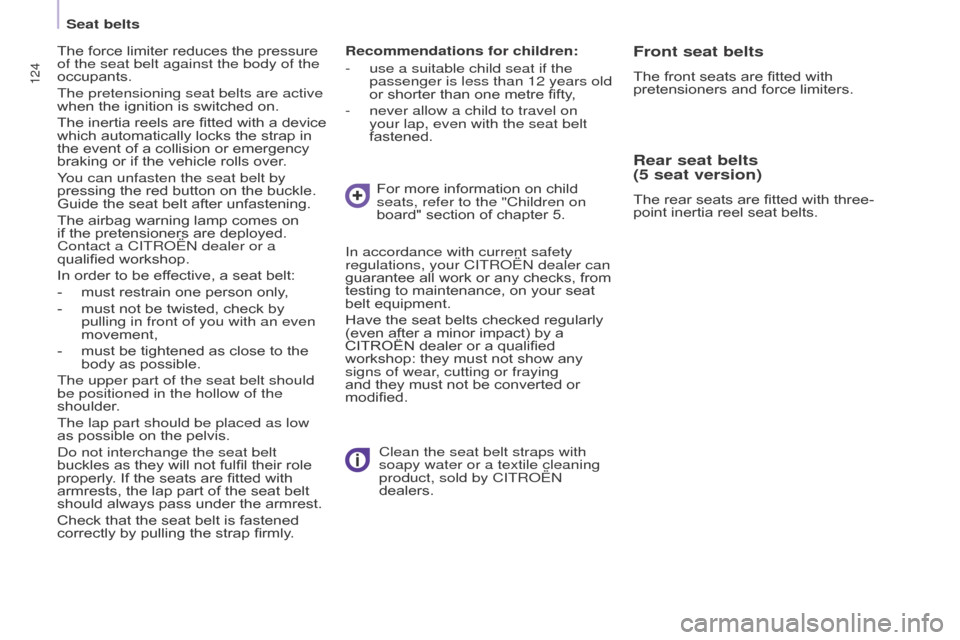
Berlingo-2-VP_en_Chap05_Securite_ed01-2015
124
Recommendations for children:
-
use a suitable child seat if the
passenger is less than 12 years old
or
shorter than one metre fifty,
-
never allow a child to travel on
your lap, even with the seat belt
fastened. For
more information on child
seats, refer to the "Children on
board"
section of chapter 5.
Clean the seat belt straps with
soapy water or a textile cleaning
product, sold by CITR
o Ë n
dealers.
In accordance with current safety
regulations, your CITR
o Ë n dealer can
guarantee
all work or any checks, from
testing
to maintenance, on your seat
belt
equipment.
Have
the seat belts checked regularly
(even
after a minor impact) by a
CITROËN
dealer or a qualified
workshop:
they must not show any
signs of wear
, cutting or fraying
and
they must not be converted or
modified.
The
force
limiter
reduces
the
pressure
of the seat belt against the body of the
occupants.
The pretensioning seat belts are active
when
the
ignition
is
switched
on.
The
inertia
reels
are
fitted
with
a
device
which
automatically
locks
the
strap
in
the
event
of
a
collision
or
emergency
braking
or
if
the
vehicle
rolls
over.
You can unfasten the seat belt by
pressing
the
red
button
on
the
buckle.
Guide
the
seat
belt
after
unfastening.
The
airbag
warning
lamp
comes
on
if
the
pretensioners
are
deployed.
Contact a CITR
o
Ë
n
dealer or a
qualified
workshop.
In
order
to
be
effective,
a
seat
belt:
-
must
restrain
one
person
only,
-
must
not
be
twisted,
check
by
pullin
g in front of you with an even
movement,
-
must
be
tightened
as
close
to
the
body
as
possible.
The upper part of the seat belt should
be positioned in the hollow of the
shoulder.
The lap part should be placed as low
as
possible
on
the
pelvis.
d
o not interchange the seat belt
buckles
as
they
will
not
fulfil
their
role
properly
.
If
the
seats
are
fitted
with
armrests,
the
lap
part
of
the
seat
belt
should
always
pass
under
the
armrest.
Check
that
the
seat
belt
is
fastened
correctly
by
pulling
the
strap
firmly.Front seat belts
The front seats are fitted with pretensioners and force limiters.
Rear seat belts
(5 seat version)
The rear seats are fitted with three-
point inertia reel seat belts.
Seat belts
Page 128 of 298

Berlingo-2-VP_en_Chap05_Securite_ed01-2015
126
AIRBAGS
General information
The airbags have been designed to
maximise the safety of the occupants
in the event of a serious collision;
they
work in conjunction with the force
limiting
seat belts. In the event of a serious collision, the
electronic detectors record and analyse
the
front and side impacts suffered in the
impact detection zones:
-
in
the event of a serious impact,
the
airbags inflate instantly and
contribute towards better protecting
the occupants of the vehicle;
immediately
after the impact, the
airbags
deflate rapidly, so that they
do not hinder the visibility of the
occupants nor their possible exit
from
the vehicle.-
in
the event of a minor or rear impact
and in certain roll-over conditions, the airbags will not be
deployed; the seat belt alone is
sufficient
to contribute towards your
protection
in these situations.
The seriousness of the collision
depends on the nature of the obstacle
and the speed of the vehicle at the
moment
of impact.
airbags
Page 129 of 298
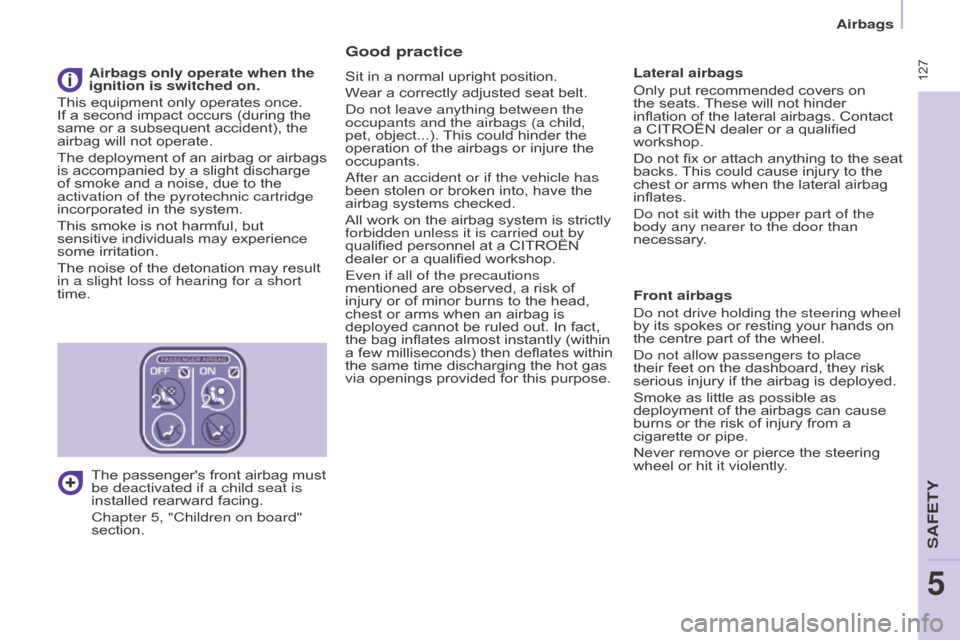
Berlingo-2-VP_en_Chap05_Securite_ed01-2015
127
Good practice
Sit in a normal upright position.
W ear a correctly adjusted seat belt.
d
o not leave anything between the
occupants and the airbags (a child,
pet,
object...).
This
could hinder the
operation
of the airbags or injure the
occupants.
a
fter an accident or if the vehicle has
been
stolen or broken into, have the
airbag
systems checked.
All
work on the airbag system is strictly
forbidden unless it is carried out by
qualified
personnel at a CITROËN
dealer
or a qualified workshop.
Even if all of the precautions
mentioned
are observed, a risk of
injury
or of minor burns to the head,
chest
or arms when an airbag is
deployed
cannot be ruled out. In fact,
the
bag inflates almost instantly (within
a
few milliseconds) then deflates within
the
same time discharging the hot gas
via
openings provided for this purpose.Lateral airbags
Only
put recommended covers on
the
seats.
These
will not hinder
inflation
of the lateral airbags. Contact
a
CITROËN dealer or a qualified
workshop.
Do
not fix or attach anything to the seat
backs.
This
could cause injury to the
chest
or arms when the lateral airbag
inflates.
d
o not sit with the upper part of the
body any nearer to the door than
necessary.
Front airbags
d
o not drive holding the steering wheel
by
its spokes or resting your hands on
the
centre part of the wheel.
d
o not allow passengers to place
their
feet on the dashboard, they risk
serious
injury if the airbag is deployed.
Smoke
as little as possible as
deployment
of the airbags can cause
burns
or the risk of injury from a
cigarette
or pipe.
Never
remove or pierce the steering
wheel
or hit it violently.
Airbags only operate when the
ignition is switched on.
This
equipment
only
operates
once.
If
a
second
impact
occurs
(during
the
same
or
a
subsequent
accident),
the
airbag
will
not
operate.
The
deployment
of
an
airbag
or
airbags
is
accompanied
by
a
slight
discharge
of
smoke
and
a
noise,
due
to
the
activation of the pyrotechnic cartridge
incorporated
in
the
system.
This
smoke
is
not
harmful,
but
sensitive
individuals
may
experience
some
irritation.
The
noise
of
the
detonation
may
result
in a slight loss of hearing for a short
time. The
passenger's
front
airbag
must
be deactivated if a child seat is
installed
rearward
facing.
Chapter 5, "Children on board"
section.
airbags
SaFETY
5